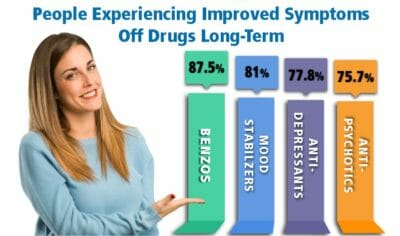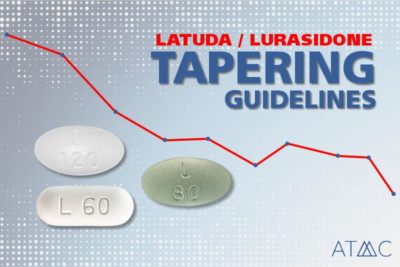1. Keks N, Schwartz D, Hope J. Stopping and switching antipsychotic drugs. Aust Prescr. 2019;42(5):152-157. doi:10.18773/austprescr.2019.052 [cited 2022 July 22]
2. Li M. Antipsychotic-induced sensitization and tolerance: Behavioral characteristics, developmental impacts, and neurobiological mechanisms. J Psychopharmacol. 2016 Aug;30(8):749-70. doi: 10.1177/0269881116654697. Epub 2016 Jul 1. PMID: 27371498; PMCID: PMC4944179. [cited 2022 July 22]
3. Davis JM, Matalon L, Watanabe MD, Blake L, Metalon L [corrected to Matalon L]. “Depot antipsychotic drugs. Place in therapy.” Drugs. 1994 May;47(5):741-73. doi: 10.2165/00003495-199447050-00004. Erratum in: Drugs 1994 Oct;48(4):616. PMID: 7520856. [cited 2022 July 22]
4. Harrow M, Jobe T, ” Long-term antipsychotic treatment of schizophrenia – does it help or hurt over a 20-year period?” Journal of World Psychiatry 2018 Jun, PMID 29856562 [cited 2022 July 22]
5. Correll et al., “What is the risk-benefit ratio of long-term antipsychotic treatment in people with schizophrenia?” Journal or World Psychiatry 2018 May [cited 2022 July 22]
6. Samaha AN, Seeman P, Stewart J, Rajabi H, Kapur S. “Breakthrough” dopamine supersensitivity during ongoing antipsychotic treatment leads to treatment failure over time. J Neurosci. 2007;27(11):2979-2986. doi:10.1523/JNEUROSCI.5416-06.2007. [cited 2022 July 22]
7. Moncrieff J, Gupta S, Horowitz MA. Barriers to stopping neuroleptic (antipsychotic) treatment in people with schizophrenia, psychosis or bipolar disorder. Ther Adv Psychopharmacol. 2020;10:2045125320937910. Published 2020 Jul 6. doi:10.1177/2045125320937910. [cited 2022 July 22]
8. WALKER, TOM. “ULYSSES CONTRACTS IN MEDICINE.” Law and Philosophy, vol. 31, no. 1, 2012, pp. 77–98. JSTOR, www.jstor.org/stable/41348267. [cited 2022 July 22]
9. Cooper RE, Hanratty É, Morant N, Moncrieff J (2019) Mental health professionals’ views and experiences of antipsychotic reduction and discontinuation. PLoS ONE 14(6): e0218711. https://doi.org/10.1371/journal.pone.0218711 [cited 2022 July 22]
10. Hedges DW, Woon FL, Hoopes SP. Caffeine-induced psychosis. CNS Spectr. 2009 Mar;14(3):127-9. doi: 10.1017/s1092852900020101. PMID: 19407709. [cited 2022 July 22]
11. Wang HR, Woo YS, Bahk WM. Caffeine-induced psychiatric manifestations: a review. Int Clin Psychopharmacol. 2015 Jul;30(4):179-82. doi: 10.1097/YIC.0000000000000076. PMID: 25856116. [cited 2022 July 22]
12. NIDA. 2020, May 28. Is there a link between marijuana use and psychiatric disorders? [cited 2022 July 22]
13. Sahoo S, Mehra A, Grover S. Acute Hyperglycemia Associated with Psychotic Symptoms in a Patient with Type 1 Diabetes Mellitus: A Case Report. Innov Clin Neurosci. 2016;13(11-12):25-27. Published 2016 Dec 1. [cited 2022 July 22]
14. Herbert C, Meixner F, Wiebking C, Gilg V. Regular Physical Activity, Short-Term Exercise, Mental Health, and Well-Being Among University Students: The Results of an Online and a Laboratory Study. Front Psychol. 2020;11:509. Published 2020 May 26. doi:10.3389/fpsyg.2020.00509 [cited 2022 July 22]
15. Segura-Aguilar J., Paris I. (2014) Mechanisms of Dopamine Oxidation and Parkinson’s Disease. In: Kostrzewa R. (eds) Handbook of Neurotoxicity. Springer, New York, NY. https://doi.org/10.1007/978-1-4614-5836-4_16 [cited 2022 July 22]
16. Kennedy WK, Jann MW, Kutscher EC. Clinically significant drug interactions with atypical antipsychotics. CNS Drugs. 2013 Dec;27(12):1021-48. doi: 10.1007/s40263-013-0114-6. PMID: 24170642.[cited 2022 July 22]
17. Sproule BA, Naranjo CA, Brenmer KE, Hassan PC. Selective serotonin reuptake inhibitors and CNS drug interactions. A critical review of the evidence. Clin Pharmacokinet. 1997 Dec;33(6):454-71. doi: 10.2165/00003088-199733060-00004. PMID: 9435993.[cited 2022 July 22]
18. Gardos G, Cole JO, Tarsy D. Withdrawal syndromes associated with antipsychotic drugs. Am J Psychiatry. 1978 Nov;135(11):1321-4. doi: 10.1176/ajp.135.11.1321. PMID: 30287.[cited 2022 July 22]
19. Tranter R, Healy D. Neuroleptic discontinuation syndromes. J Psychopharmacol. 1998;12(4):401-6. doi: 10.1177/026988119801200412. PMID: 10065916. [cited 2022 July 22]
20. Fink EB. Unexpected and prolonged akinesia: a case report. J Clin Psychiatry. 1978 Nov;39(11):817-8. PMID: 31353. [cited 2022 July 22]
21. Hormone Health Network Non-Diabetic Hypoglycemia EDITOR(S): Prof. Margaret Eckert-Norton, PHD, FNP-BC, CDE, Ramon Martinez, M.D., Susan Kirk, M.D. LAST UPDATED: July 2020. [cited 2022 July 22]
22. FDA label LATUDA (lurasidone hydrochloride) Approved 2010 Revised 2013 [cited 2022 July 22]
23. Barnes SS, Badre N. Is the Evidence Strong Enough to Warrant Long-Term Antipsychotic Use in Compulsory Outpatient Treatment? Psychiatr Serv. 2016 Jul 1;67(7):784-6. doi: 10.1176/appi.ps.201500408. Epub 2016 Mar 15. PMID: 26975525. [cited 2022 July 22]
24. Ostrow L, Jessell L, Hurd M, Darrow SM, Cohen D. Discontinuing Psychiatric Medications: A Survey of Long-Term Users. Psychiatr Serv. 2017 Dec 1;68(12):1232-1238. doi: 10.1176/appi.ps.201700070. Epub 2017 Jul 17. PMID: 28712356. [cited 2022 July 22]
25. Salomon C, Hamilton B. “All roads lead to medication?” Qualitative responses from an Australian first-person survey of antipsychotic discontinuation. Psychiatr Rehabil J. 2013 Sep;36(3):160-5. doi: 10.1037/prj0000001. Epub 2013 Jul 1. PMID: 23815172. [cited 2022 July 22]
26. Behan C. The benefits of meditation and mindfulness practices during times of crisis such as COVID-19. Ir J Psychol Med. 2020 Dec;37(4):256-258. doi: 10.1017/ipm.2020.38. Epub 2020 May 14. PMID: 32406348; PMCID: PMC7287297. [cited 2022 July 22]
27. Meister K, Becker S. Yoga bei psychischen Störungen [Yoga for mental disorders]. Nervenarzt. 2018 Sep;89(9):994-998. German. doi: 10.1007/s00115-018-0537-x. PMID: 29858642. [cited 2022 July 22]
28. Antonelli M, Barbieri G, Donelli D. Effects of forest bathing (shinrin-yoku) on levels of cortisol as a stress biomarker: a systematic review and meta-analysis. Int J Biometeorol. 2019 Aug;63(8):1117-1134. doi: 10.1007/s00484-019-01717-x. Epub 2019 Apr 18. PMID: 31001682. [cited 2022 July 22]
29. Raglan GB, Swanson LM, Arnedt JT. Cognitive Behavioral Therapy for Insomnia in Patients with Medical and Psychiatric Comorbidities. Sleep Med Clin. 2019 Jun;14(2):167-175. doi: 10.1016/j.jsmc.2019.01.001. Epub 2019 Mar 29. PMID: 31029184. [cited 2022 July 22]
30. Schuch FB, Vancampfort D. Physical activity, exercise, and mental disorders: it is time to move on. Trends Psychiatry Psychother. 2021 Jul-Sep;43(3):177-184. doi: 10.47626/2237-6089-2021-0237. Epub 2021 Apr 21. PMID: 33890431; PMCID: PMC8638711. [cited 2022 July 22]
31. Sharpe PA, Williams HG, Granner ML, Hussey JR. A randomised study of the effects of massage therapy compared to guided relaxation on well-being and stress perception among older adults. Complement Ther Med. 2007 Sep;15(3):157-63. doi: 10.1016/j.ctim.2007.01.004. Epub 2007 Feb 20. PMID: 17709060. [cited 2022 July 22]
32. Shechter A, Kim EW, St-Onge MP, Westwood AJ. Blocking nocturnal blue light for insomnia: A randomized controlled trial. J Psychiatr Res. 2018 Jan;96:196-202. doi: 10.1016/j.jpsychires.2017.10.015. Epub 2017 Oct 21. PMID: 29101797; PMCID: PMC5703049. [cited 2022 July 22]
33. Ferracioli-Oda E, Qawasmi A, Bloch MH. Meta-analysis: melatonin for the treatment of primary sleep disorders. PLoS One. 2013 May 17;8(5):e63773. doi: 10.1371/journal.pone.0063773. PMID: 23691095; PMCID: PMC3656905. [cited 2022 July 22]
34. Matsuoka Y, Hamazaki K. [Considering Mental Health from the Viewpoint of Diet: The Role and Possibilities of Nutritional Psychiatry]. Seishin Shinkeigaku Zasshi. 2016;118(12):880-894. Japanese. PMID: 30620820. [cited 2022 July 22]
35. Bilal M, Iqbal HMN. An insight into toxicity and human-health-related adverse consequences of cosmeceuticals – A review. Sci Total Environ. 2019 Jun 20;670:555-568. doi: 10.1016/j.scitotenv.2019.03.261. Epub 2019 Mar 20. PMID: 30909033. [cited 2022 July 22]
36. Ratnaseelan AM, Tsilioni I, Theoharides TC. Effects of Mycotoxins on Neuropsychiatric Symptoms and Immune Processes. Clin Ther. 2018 Jun;40(6):903-917. doi: 10.1016/j.clinthera.2018.05.004. Epub 2018 Jun 5. PMID: 29880330. [cited 2022 July 22]
37. Hardin BD, Kelman BJ, Saxon A. Adverse human health effects associated with molds in the indoor environment. J Occup Environ Med. 2003 May;45(5):470-8. doi: 10.1097/00043764-200305000-00006. PMID: 12762072. [cited 2022 July 22]

 Do not begin tapering Latuda when you are unstable.6,7
Do not begin tapering Latuda when you are unstable.6,7 Nutritional evaluation, testing, and corrective diet and supplementation are begun early in the program so that situations such as deficiencies or out-of-balance minerals and other bio-factors can begin to be repaired without delay. Meals are prepared within the framework of a delicious, nutrient-dense, and mostly organic diet, using unprocessed foods without chemicals, additives, or preservatives. The elimination of stimulants such as caffeine or sugars and neurotoxic artificial sweeteners, flavor enhancers, etc., can also benefit greatly.
Nutritional evaluation, testing, and corrective diet and supplementation are begun early in the program so that situations such as deficiencies or out-of-balance minerals and other bio-factors can begin to be repaired without delay. Meals are prepared within the framework of a delicious, nutrient-dense, and mostly organic diet, using unprocessed foods without chemicals, additives, or preservatives. The elimination of stimulants such as caffeine or sugars and neurotoxic artificial sweeteners, flavor enhancers, etc., can also benefit greatly.








